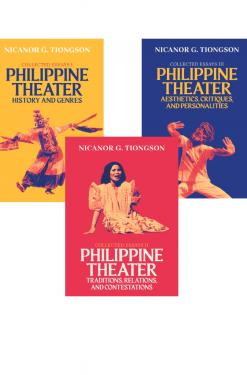
Philippine Theater History and Genres, the first volume of Nicanor Tiongson’s trilogy of collected theater essays, is composed of two parts. The first puts together his three most important essays on the historical development of Philippine theater from its earliest beginnings to 2023, including the well-known essay “What Is Philippine Drama?” which uses the RPN (“Repleksiyon ng Pangangailangan ng Nakararami”) framework for the analysis of Philippine plays as well as the more recent “TAPAT: Teatro para sa TAO,” which refines the RPN criteria. The second part anthologizes comprehensive essays on the principal genres of Philippine theater: 1) the indigenous mimetic rituals, dances, customs, and dance dramas; the Hispanic-influenced forms like 2) the verse play komedya; 3) the Lenten passion play sinakulo; 4) the comic skits called sainete and entremes; 5) the play in prose with music called sarsuwela; 6) the American influenced bodabil and stage show; and 7) the original plays by contemporary playwrights using realistic and non-realistic styles.
Philippine Theater Traditions, Relations, and Contestations, the second volume of Nicanor Tiongson’s trilogy of collected theater essays, is divided into three parts. The first, “Tradition and Innovation in Philippine Theater,” has one article illustrating how the traditional komedya, sinakulo, and sarsuwela, among others, have been revitalized with progressive messages; a study showing how Palasyo ni Valentin subverted the elements of the traditional sarsuwela to get the form out of its box; a personal account narrating how Ramayana drama traditions of Southeast Asia were transformed in ASEAN’s Realizing Rama through the process of “inter-creation”; an article showing how the Indian Ramayana was indigenized by Filipino artists in their literary, dance, and theater productions; and an analysis of how Jose Rizal’s two novels were contemporanized to expose the corruption behind illegal logging that devastates lives and properties. The second part, “Philippine Theater and Its Oriental and Occidental Relations,” traces the sources and influences of Philippine theater in an article describing three folk playlets found in both Mexico and the Philippines; a study showing how the Philippine sarsuwela descended from the Spanish zarzuela and Filipinized it; and an article showing how Japanese dramas influenced Philippine contemporary plays. The third part, “Contesting Ideas and Ideologies in Philippine Theater,” has an analysis of how three plays of 1902 espoused conflicting positions on the American invasion of the islands; a critique of the plays staged against the Marcos dictatorship in the Makiisa II festival of 1984; a description of how Manila theater groups responded to Rodrigo Duterte’s wars on drugs, truth, and memory; and a study of how the púsong (jester) embodied the voice of the people in Tagalog traditional and modern plays.
Philippine Theater Aesthetics, Critiques, and Personalities, the third volume in Nicanor Tiongson’s trilogy of collected theater essays, is comprised of three parts. The first, “Criteria and Considerations in the Evaluation of Philippine Theater,” consists of an essay that proposes four approaches in the analysis of theater performances, the last of which is the use of “kamalayang Pilipino na maka-TAO” as the most important criterion for evaluation; a critique of the sarsuwela Walang Sugat by Severino Reyes, using the four approaches presented in the first essay; and an initial study which tries to define what might be called the “dating” or aesthetics of Philippine theater. The second part, “Reviews of Philippine Theater Performances and Books,” compiles selected reviews of a few books on Philippine theater and many performances of plays staged mostly in the 1970s by the Philippine Educational Theater Association (PETA), Babaylan, UP Repertory Company, and others, using the RPN criteria. The third part, “Artists and Groups in Philippine Theater,” anthologizes articles on the life and works of theater enthusiast Juan Atayde, writer-producer-actors Aurelio Tolentino and Atang de la Rama, bodabil singer and actress Katy de la Cruz, and theater designer Salvador F. Bernal, as well as essays on theater groups of the 1970s and 1980s and their productions, like the PETA, Babaylan, UP Repertory Company, Repertory Philippines, Teatro Pilipino, and Bulwagang Gantimpala.
Published in 2024.




